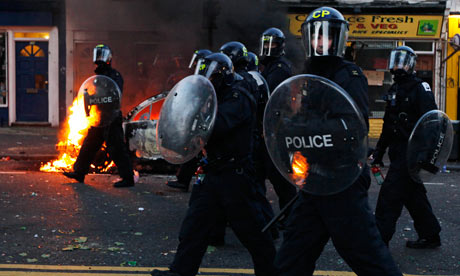London riots: police debate how far they should go to regain control

The Guardian, UK
He expanded on the reason not to fire baton rounds: “We had people as young as 11 being arrested for looting last night. Do we genuinely want to see the police of London using that type of tactic on 11-year-olds? We have to be very careful about what we use and how we’re using it.”
Pictures of officers standing and watching as youths smashed and looted shops have puzzled the public
The biggest outbreak of rioting to hit Britain in living memory has led to debates within the police service about how far forces should go to regain control of the streets. Pictures of police officers standing and watching as youths smashed and looted shops have puzzled the public.
But Steven Kavanagh, the Metropolitan police deputy assistant commissioner, denied those images were a sign of the force being soft on rioters: “The Met is not namby pamby,” he told the Guardian.
He added: “The face of policing has changed, 25-30 years ago it would have been a different response, we’d have gone to baton rounds and water cannon straight away. Now we are more measured.”
He said the police faced contrasting demands from the public: “There are two extremes, the hang ’em and flog ’em brigade, and those who say these are frustrated youngsters.”
Twenty-five years ago, Kavanagh said, officers might have “let anger get the better of themselves”, and go wading in, but he said there was now a more disciplined approach, with officers not charging in as they were “holding the line” to protect firefighters putting out blazes that threatened life.
With police numbers stretched beyond anything experienced in living memory, another source said commanders had to make tough choices. “Sometimes you will let offences take place because you can’t afford to lose two to three officers for every arrest. The priority is not to protect property but to protect life. There will be no order to be soft.”
At a Scotland Yard press conference Kavanagh said the Met was considering using baton rounds. But there is huge debate among the police leadership about the wisdom of such a move.
Kavanagh said of the option of using the devices: “The Met does not wish to use baton rounds but if it gets put into a position that it needs to protect the people and the property and the lives of Londoners, [then] we will do so.”
He expanded on the reason not to fire baton rounds: “We had people as young as 11 being arrested for looting last night. Do we genuinely want to see the police of London using that type of tactic on 11-year-olds? We have to be very careful about what we use and how we’re using it.”
Another source said that it would be too early to use baton rounds: “They are for use when there is mortal danger, such as at Broadwater Farm. Here, we’re in mortal danger of losing control of the streets and of shops being looted. It would be disproportionate.”
Baton rounds can only be “deployed”, or, given to officers to use, on the direct orders of the commissioner of the Metropolitan police. They have never been fired on the British mainland. Outside London, a chief constable is required to authorise their deployment.
Specially trained officers attached to C019, the elite firearms unit, fire the single baton rounds from devices that look like shotguns.
Brian Paddick, Scotland Yard’s former deputy assistant commissioner, who has trained in the deployment of baton rounds, said: “If you believe you are losing control of the situation, it is a legitimate tactic. They are quite effective in dispersing crowds. The advantage is you can put a lot of distance between you and the crowd. The downside is, if you hit someone in the wrong place you can kill them.”
One senior officer, involved in drawing up plans to quell riots in his area, said he would favour authorising use of baton rounds if they were needed. “When you’ve got a big crowd who are intent on over-running your officers, I don’t see the big deal in using them. You can withdraw or use baton rounds, which are more under your control than using dogs. I don’t see it as crossing a Rubicon for British policing – it’s much better than a baton charge where you can’t control the level of violence officers use.”
Paddick explained how the devices would be used in London: “There is a public-order commander on the ground who sends a message to the commissioner that all conventional means to contain the crowd has failed. The commissioner then gives the designated senior officer authority to use them. “When the DSO, having been given the authority, believes the situation is beyond conventional means, they can then be used.”
Baton rounds were issued to officers at the Broadwater Farm riots in Tottenham, London, in 1985, but were not used.
Paddick said the weapons had been issued, every year for at least the last 10 years, for the Notting Hill carnival, in London. “It is there, if there is a riot and conventional tactics can’t contain the violence.”
For police the scale and intensity of the recent riots are creating a need for new thinking, in a race against time to quell the unrest. One source said: “It is beyond the experience of anything we have experienced. If a bomb goes off we know what to do. This is as highly challenging as anything could be.”

